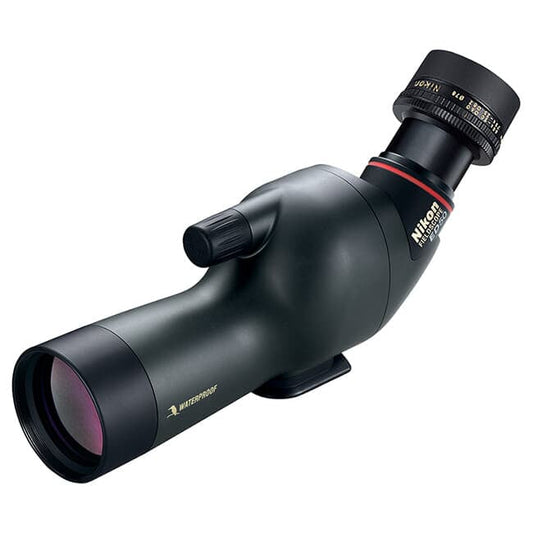

The Nikon 13-30x50 Angled Body ED Spotting Scope 8321 is built with advanced multicoated extra-low dispersion (ED) glass to deliver sharp, high-contrast images with true color fidelity. Its optical design minimizes chromatic aberration, providing clear details even at maximum magnification. The scope features a 50mm lens diameter that gathers ample light, ensuring bright images during dawn, dusk, or low-light conditions. Its compact, lightweight construction—weighing just 16.6 ounces—makes it easy to carry in your backpack or binocular case, ideal for outdoor activities like birdwatching, wildlife observation, or landscape viewing. The angled eyepiece enhances ergonomic comfort, allowing prolonged viewing sessions without fatigue. Fully waterproof and fogproof, thanks to nitrogen filling and O-ring sealing, this spotting scope performs reliably in all weather environments. Its adjustable magnification from 13x to 30x offers versatile viewing options, whether you need close-up detail or distant landscape views. Compatible with digiscoping accessories, this scope allows effortless attachment of cameras for high-quality photography. Overall, the Nikon 13-30x50 ED Spotting Scope is a dependable, high-performance tool designed to meet the demands of serious outdoor enthusiasts and hobbyists alike.
Features
- HIGH GRADE OPTICS provide edge-to-edge sharpness and high-definition clarity, ensuring detailed observation in any lighting condition for birdwatching and nature study.
- LIGHTWEIGHT DESIGN offers excellent portability, weighing only 16.6 oz, making it easy to carry during long outdoor excursions or hikes without fatigue.
- EXTRA-LOW DISPERSION GLASS reduces chromatic aberration, delivering true-to-life colors and crisp images for accurate wildlife identification and landscape viewing.
- FULL MULTICOATING TECHNOLOGY enhances light transmission, resulting in brighter, clearer images in low-light conditions like dawn or dusk, ideal for early morning or evening observations.
- WATERPROOF & FOGPROOF construction, with nitrogen filling and O-ring seals, ensures durability and fog resistance across different weather scenarios, from rain to humidity.
- ADJUSTABLE MAGNIFICATION from 13x to 30x offers versatile viewing capabilities, allowing for close-up detail or broader landscape perspectives on demand.
- ERGONOMIC ANGLED DESIGN enhances comfort during extended viewing sessions, reducing neck strain and providing a natural viewing posture for users of various heights.
- DIGISCOPING COMPATIBILITY allows seamless attachment of cameras, enabling high-quality image capture and sharing without compromising optical performance.
Technical Specifications Table
| Specification | Details |
|---|---|
| Magnification Range | 13x - 30x |
| Objective Lens Diameter | 50 mm |
| Field of View | 157 ft @ 1000 yards |
| Exit Pupil | 3.8 mm @ 13x |
| Eye Relief | 12.9 mm @ 13x |
| Close Focus Range | 9.8 ft |
| Weight | 16.6 oz |
| Body Type | Angled |
What’s in the Box?
- Sliding sunshade
- 13-30x zoom eyepiece
- Eyepiece travel pouch
- Lens covers
- Adjustable carry strap
Customer Reviews
"The clarity of this scope is incredible! The ED glass really makes a difference when spotting details." - James P.
"Lightweight and easy to use, perfect for my birdwatching trips. Highly recommended!" - Linda T.
FAQ
What distinguishes the Nikon 13-30x50 ED Spotting Scope from other models? Its use of ED glass and full multicoating technology significantly improve image clarity and brightness, especially in low-light environments. These features reduce chromatic aberration and glare, making it ideal for precise observation.
Is this scope suitable for all weather conditions? Yes, it is designed with waterproof and fogproof construction, thanks to nitrogen filling and O-ring sealing. This ensures reliable performance during rain, humidity, or cold weather, protecting the internal optics from moisture and fog buildup.
Can I attach a camera to this scope for digiscoping? Absolutely. The Nikon 13-30x50 ED Spotting Scope is compatible with digiscoping accessories, enabling you to capture high-quality images directly through the scope. This feature makes it perfect for wildlife photographers and nature lovers who want to document their observations.
How does this scope compare to larger models? While larger scopes offer higher magnification and sometimes more detailed views, the Nikon 13-30x50 ED balances portability with excellent optical performance. Its lightweight design makes it easier to carry and handle, especially for extended outdoor use.
What maintenance is required to keep the optics in optimal condition? Regularly clean the lenses with a soft, lint-free cloth and use lens cleaning solution if needed. Keep the scope in its protective pouch when not in use and store it in a dry, cool place to preserve its optical quality over time.
Similar Models
Looking for more exceptional optics? Explore our complete lineup of Nikon spotting scopes, including the Nikon Prostaff 20-60x82 and Nikon Aculon A211 16-48x65. Each model offers unique features tailored to different observation needs. Browse our full collection today for reliable, high-performance optics for your outdoor adventures.
You May Also Like
Here’s some of our most similar products people are buying. Click to discover trending style.






